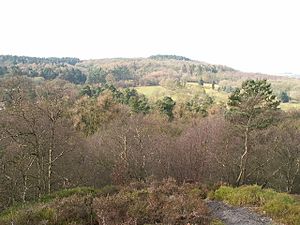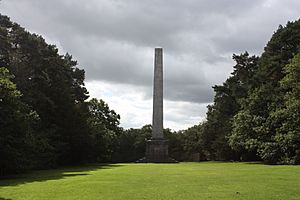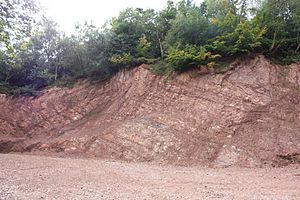Lickey Hills Country Park facts for kids
Quick facts for kids Lickey Hills Country Park |
|
|---|---|

Lickey Hills Country Park, from Bilberry Hill over Rosehill Road and the Birmingham Municipal Golf Course towards Beacon Hill. Bilberry bushes in the foreground.
|
|
| Location | Birmingham, England |
| Area | 524 acres (212 ha) |
| Operated by | Birmingham City Council |
| Awards | Green Flag |
| Public transit access | Barnt Green railway station |
Lickey Hills Country Park is a beautiful park in England. It is about 10 miles (16 kilometres) southwest of Birmingham. The park covers a large area of 524 acres (212 ha). It is located near the towns of Rednal and Barnt Green. This park is one of the oldest ones managed by Birmingham City Council. The highest point in the park is Beacon Hill, which is 298 meters (977 feet) above sea level.
The park exists today thanks to a group called the Birmingham Society for the Preservation of Open Spaces. This group bought some land and arranged for other parts to be leased. Important people like George Cadbury and his wife Dame Elizabeth Cadbury were part of this group. They gave the first part of the park to the people of Birmingham in 1888. More land was added until 1933. This means the park has always been free for everyone to visit.
The Lickey Hills quickly became a popular place for fun. Many visitors came between 1924 and 1953 because a tram service connected to the park. In 1919, about 20,000 people visited on one holiday! The park became a "Country Park" in 1971. Today, over 500,000 people visit each year. It is known as one of the prettiest parks in the West Midlands. It has also won a Green Flag Award.
Contents
Discovering the Past: History of Lickey Hills
The Lickey Hills have been important for a very long time. People lived here as far back as the Stone Age. A Neolithic hunter lost a flint arrow head on Rednal Hill over 4,000 years ago. Another flint tool was found near the Earl of Plymouth monument. These old tools are now on display at the Birmingham Museum.
Roman Times and Ancient Roads
The Romans built a Roman road right over the Lickeys. This road was used to move salt and other goods. It also served as a path for Roman soldiers. In 1963, a small Roman coin was found near Rednal Hill School. This coin was made during the time of Emperor Antoninus Pius, who ruled from 138 to 161 AD. It was worth about the price of a loaf of bread.

Norman Times and Royal Forests
During Norman times, the Lickeys were part of a royal manor. They were used as a royal hunting forest. This meant the area was stocked with deer. The Normans also brought rabbits to the area. These rabbits were kept in special enclosures called 'warrens'. This is why some local road names include "Warren." The word 'forest' meant a place for deer, not necessarily a place full of trees.
In 1682, the land was sold to the Earl of Plymouth. His family owned the land for the next 250 years.
How the Park Was Created
In 1888, the Birmingham Society for the Preservation of Open Spaces bought Rednal Hill. They gave it to the city to protect it. They also arranged to lease Pinfield Wood and Bilberry Hill for a very small rent. Later, in 1920, Birmingham City Council bought Cofton Hill, Lickey Warren, and Pinfield Wood. By 1923, they bought the Rose Hill Estate from the Cadbury family. This made the entire hills open to the public for free.
In 1904, Mr. and Mrs. Barrow Cadbury gave the Lickey Tea Rooms building to the people of Birmingham. It was a place for visitors to rest and get refreshments. Today, this building is called the Bilberry Hill Centre. It is a hostel and sports facility for young people.
For many people from Birmingham and the Black Country, the Lickey Hills were a favorite day trip. The Birmingham tram network used to bring large crowds to the park. People would queue for trams to take them home on busy Sundays. The tram tracks were removed in 1953.
Exploring the Park: Geography and Facilities
The Lickey Hills area is very interesting for its rocks. It has many different types of rocks of various ages. This variety creates the park's diverse landscape and habitats.

The park covers 524 acres (2.12 km2). It includes an 18-hole golf course. This was the first public golf course in the country. It was known as one of the most challenging public golf courses in the 1970s.
The Lickey Hills are part of a larger ridge. These hills separate the Longbridge and Cofton Hackett areas of Birmingham from the more rural areas of Barnt Green and Lickey in Worcestershire.
What You Can Do at the Park
Inside the park, you can find many things to do:
- An 18-hole public golf course.
- A bowling green.
- Tennis courts and a putting green.
- A special wheelchair pathway and viewing platform. This allows easy access to amazing views of the countryside.
The visitor centre opened in 1990. It has exhibitions, maps, and information about nature trails. You can also learn about guided walks and other activities run by the Ranger Service. There is a small cafe, a gift shop, and toilets.
There are three car parks in the park. One is by the visitor centre, another by the golf club, and one at the top of Beacon Hill. Near the visitor centre, there is also a children's play area. Paths for disabled visitors are available, but they are limited due to the park's steep hills. Between the Bilberry, Beacon, and Rednal Hills, you will find The Rose & Crown hotel and pub.
The Lickey Hills Country Park has won a Green Flag Award for many years in a row. This award recognizes the best green spaces in the country. Parks are judged on their management, cleanliness, and how the community uses them.
Wildlife in the Lickey Hills: Flora and Fauna
The park is home to many animals and plants. You might see several types of deer and badgers. The lake has many water birds like Canada geese, mallards, coots, moorhens, and swans. In spring, you can see beautiful displays of bluebells.
Trees and Plants
The forests in the park mostly have mature spruce and pine trees. There are also many different types of deciduous trees on the lower slopes. Bilberry Hill is named after the many bilberry bushes there. These bushes have fruit in early to mid-autumn. Walkers often pick the berries to make jams or pies.
The park has over 380 different types of flowering plants. This includes 17 types of ferns and 30 types of mosses.
Insects and Birds
The woodlands are home to many insects like beetles, centipedes, and slugs. Flies, bees, and butterflies also live here. These insects are food for larger wildlife.
Ninety types of birds have been seen in the park. These include the European robin, common chaffinch, blue tit, great tit, and common wood pigeon. Some birds, like willow warblers and tree pipits, visit in the summer. Others, like fieldfare and redwing, come in the winter. You can often see nuthatches at the bird feeders near the cafe.
Reptiles and Other Animals
The damp woodland ground is also home to different reptiles. These include grass snakes, adders, and the common lizard. The most common animals you will see are grey squirrels in the woods and rabbits on the hills. The park is very popular with walkers, families, and birdwatchers.
Getting There: Public Transport
It's a short walk from local public transport stops to the main park visitor centre.
Bus Services
Diamond Worcestershire services 182 and 183 start at Lickey Square and go to Redditch. Diamond services 145/145A and National Express West Midlands route X20 from Birmingham City Centre also stop nearby.
Train Services
The closest train station is Barnt Green. You can catch frequent trains on the Birmingham Cross-City line from Bromsgrove/Redditch in the south and Birmingham City Centre/Lichfield in the north.
Special Landmarks: Obelisk and Toposcope
On the road from Lickey to Lickey Beacon, there is an obelisk. This monument remembers Other Archer Windsor, 6th Earl of Plymouth. He created a volunteer cavalry group called the Worcestershire Yeomanry. This group fought in the Napoleonic Wars. The obelisk has words carved on it that praise the Earl.
Just a short distance north of the monument, on top of Beacon Hill, is the toposcope. The Cadbury family made this in the early 1900s. It stands next to an Ordnance Survey triangulation point. In 1988, a small castle-like structure was built to protect the toposcope. This was to celebrate 100 years of the park. Beacon Hill is 297 meters above sea level. It offers the best views of the city and the surrounding areas.

